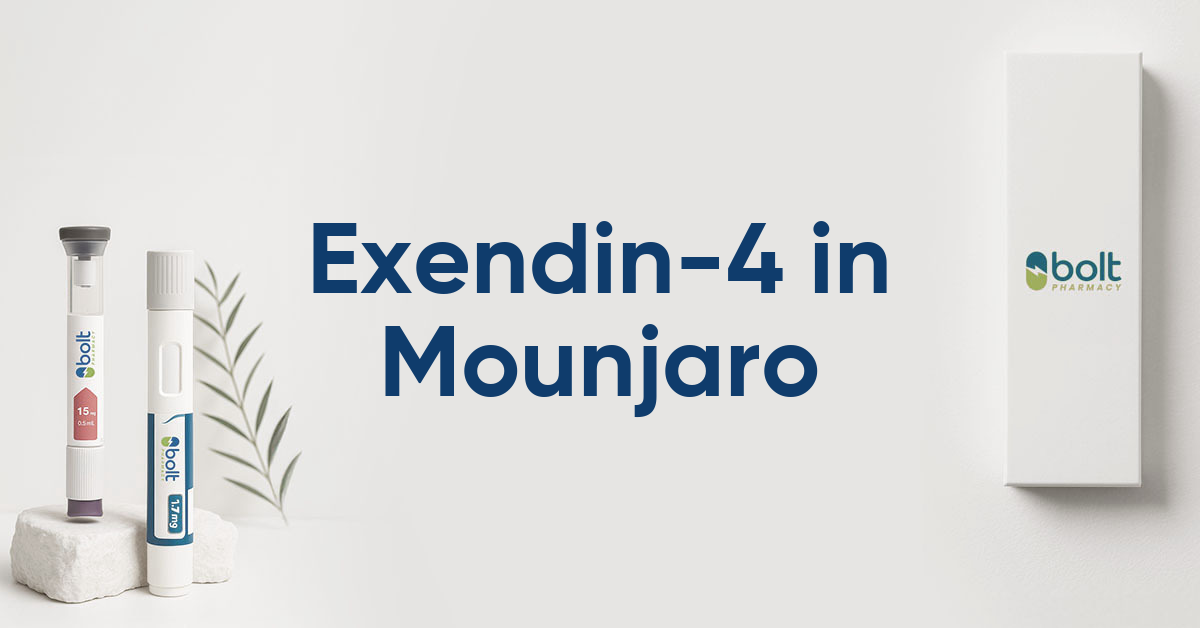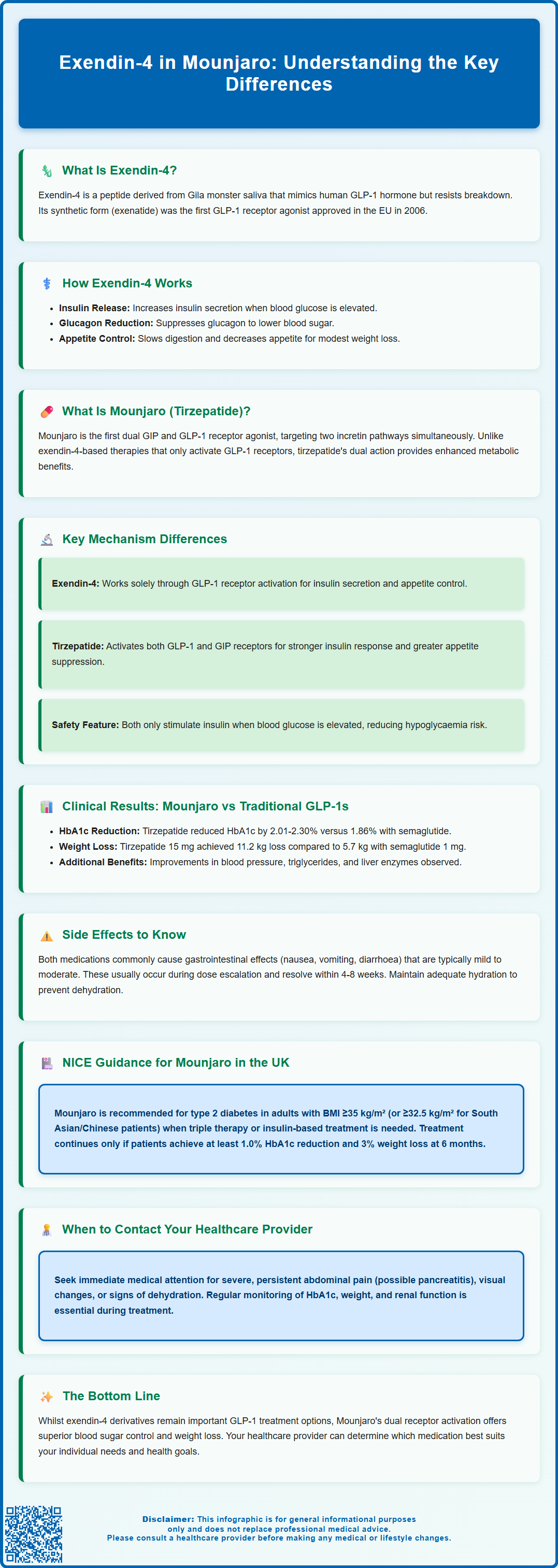Wegovy®
A weekly GLP-1 treatment proven to reduce hunger and support meaningful, long-term fat loss.
- ~16.9% average body weight loss
- Boosts metabolic & cardiovascular health
- Proven, long-established safety profile
- Weekly injection, easy to use

Exendin-4 is not present in Mounjaro (tirzepatide). Whilst exendin-4 is a naturally occurring peptide from Gila monster saliva that forms the basis of the GLP-1 receptor agonist exenatide, Mounjaro represents a distinct therapeutic class. Tirzepatide is the first dual glucose-dependent insulinotropic polypeptide (GIP) and GLP-1 receptor agonist, structurally based on native GIP rather than exendin-4. This dual mechanism distinguishes Mounjaro from exendin-4-based therapies, offering enhanced glycaemic control and weight reduction in type 2 diabetes. Understanding these differences is essential for appropriate prescribing under NICE guidance and optimising patient outcomes in UK clinical practice.
Summary: Exendin-4 is not a component of Mounjaro; tirzepatide is a dual GIP and GLP-1 receptor agonist structurally based on native GIP, not exendin-4.
Exendin-4 is a naturally occurring peptide originally isolated from the saliva of the Gila monster lizard (Heloderma suspectum). This 39-amino acid peptide shares approximately 53% sequence homology with human glucagon-like peptide-1 (GLP-1), a key incretin hormone involved in glucose homeostasis. The discovery of exendin-4 in the 1990s revolutionised diabetes treatment by demonstrating that GLP-1 receptor agonism could effectively lower blood glucose levels whilst promoting weight loss.
Exendin-4 binds to and activates GLP-1 receptors found predominantly in pancreatic beta cells, the gastrointestinal tract, and the central nervous system. Unlike endogenous GLP-1, which has a half-life of only 1–2 minutes due to rapid degradation by the enzyme dipeptidyl peptidase-4 (DPP-4), exendin-4 exhibits resistance to DPP-4 breakdown. This extended stability allows for therapeutic application in managing type 2 diabetes mellitus.
The synthetic form of exendin-4, known as exenatide, became the first GLP-1 receptor agonist licensed for clinical use in the EU in 2006. Exenatide is administered via subcutaneous injection and works by enhancing glucose-dependent insulin secretion, suppressing inappropriate glucagon release, slowing gastric emptying, and promoting satiety. These combined effects result in improved glycaemic control and modest weight reduction.
Clinical trials have demonstrated that exendin-4-based therapies reduce HbA1c levels by approximately 9-16 mmol/mol (0.8–1.5%) when added to existing oral antidiabetic agents. Common adverse effects include nausea, vomiting, diarrhoea, and constipation, which typically diminish over time. Patients should be advised about the risk of dehydration with these gastrointestinal effects and the importance of maintaining fluid intake. Gallbladder-related events have also been reported with GLP-1 receptor agonists as a class. Thyroid C-cell tumours have been observed in rodent studies, though no causal link has been established in humans.
It's worth noting that other GLP-1 receptor agonists such as liraglutide and semaglutide are based on human GLP-1 analogues rather than exendin-4. Exendin-4 derivatives remain an important therapeutic option, particularly for patients requiring injectable therapy alongside metformin or other oral agents.
Mounjaro (tirzepatide) is a novel glucose-lowering medication licensed in the UK for the treatment of type 2 diabetes mellitus in adults. Manufactured by Eli Lilly, Mounjaro received marketing authorisation from the Medicines and Healthcare products Regulatory Agency (MHRA) in 2022 and represents an advancement in incretin-based therapies.
The fundamental difference between Mounjaro and exendin-4-based therapies lies in their mechanism of action. Whilst exendin-4 and its synthetic derivative exenatide act solely as GLP-1 receptor agonists, tirzepatide is the first dual glucose-dependent insulinotropic polypeptide (GIP) and GLP-1 receptor agonist. This dual agonism represents a novel pharmacological approach, targeting two complementary incretin pathways simultaneously rather than one.
Structurally, tirzepatide is a 39-amino acid synthetic peptide based on the native GIP sequence, modified with a C20 fatty diacid moiety to enable albumin binding and prolong its half-life. This modification allows for once-weekly subcutaneous administration, compared to the twice-daily or once-weekly formulations of exendin-4-based products. The molecular design of tirzepatide differs substantially from exendin-4, despite both compounds ultimately influencing incretin signalling.
In terms of clinical outcomes, head-to-head trials have demonstrated efficacy differences between tirzepatide and selective GLP-1 receptor agonists. The SURPASS-2 trial compared tirzepatide with semaglutide 1 mg weekly, showing that tirzepatide achieved HbA1c reductions of 2.01%, 2.24%, and 2.30% at doses of 5 mg, 10 mg, and 15 mg respectively, versus 1.86% with semaglutide. Weight loss was also greater with tirzepatide 15 mg, producing a mean reduction of 11.2 kg compared to 5.7 kg with semaglutide 1 mg. These enhanced effects are attributed to the action of dual receptor activation, though the precise mechanisms underlying GIP and GLP-1 receptor crosstalk remain an active area of research.

Understanding the mechanistic differences between tirzepatide and exendin-4-based therapies is essential for appreciating their distinct clinical profiles. Exendin-4 derivatives function exclusively through GLP-1 receptor activation. Upon binding to GLP-1 receptors on pancreatic beta cells, these agents stimulate glucose-dependent insulin secretion via increased cyclic AMP (cAMP) production and subsequent calcium influx. Simultaneously, they suppress glucagon secretion from alpha cells, reducing hepatic glucose output. Additional effects include delayed gastric emptying and enhanced satiety through central nervous system pathways, contributing to weight loss.
Tirzepatide's dual agonism introduces an additional dimension through GIP receptor activation. GIP, like GLP-1, is an incretin hormone secreted by intestinal K cells in response to nutrient intake. Whilst GIP receptors are also present on pancreatic beta cells and adipocytes, their role in glucose homeostasis has been debated. Early research suggested GIP receptor signalling might be impaired in type 2 diabetes; however, recent evidence indicates that combined GIP and GLP-1 receptor activation may produce complementary metabolic benefits.
The proposed mechanisms for tirzepatide's efficacy include:
Augmented insulin secretion: GIP receptor activation may complement GLP-1-mediated insulin release, particularly in the postprandial state
Potential effects on insulin sensitivity: Emerging evidence suggests GIP signalling in adipose tissue might influence lipid metabolism
Weight reduction: Dual agonism appears to produce pronounced effects on appetite suppression
Effects on lipid parameters: Early data suggest GIP receptor activation may influence lipid metabolism alongside GLP-1 effects
Both tirzepatide and exendin-4-based agents exhibit glucose-dependent mechanisms, meaning insulin secretion is enhanced only when blood glucose levels are elevated. This inherent safety feature substantially reduces hypoglycaemia risk compared to insulin or sulphonylureas. However, when combined with these agents, dose adjustments may be necessary to prevent hypoglycaemic episodes.
The SURPASS clinical trial programme evaluated tirzepatide's efficacy and safety across diverse patient populations with type 2 diabetes. SURPASS-2 directly compared tirzepatide (5 mg, 10 mg, and 15 mg weekly) against semaglutide 1 mg weekly, demonstrating HbA1c reductions of 2.01% (22 mmol/mol), 2.24% (24 mmol/mol), and 2.30% (25 mmol/mol) respectively, versus 1.86% (20 mmol/mol) with semaglutide. Weight loss was similarly enhanced, with tirzepatide 15 mg producing a mean reduction of 11.2 kg compared to 5.7 kg with semaglutide.
In the SURPASS trials, tirzepatide helped many participants reach target HbA1c levels, with 51–62% of participants in SURPASS-1 reaching HbA1c <39 mmol/mol (5.7%) at the highest dose. Secondary and exploratory outcomes showed improvements in systolic blood pressure (7–10 mmHg), triglycerides, and liver enzymes, suggesting potential benefits beyond glycaemic control, though these are not licensed indications.
Adverse effects of Mounjaro are similar to those of GLP-1 receptor agonists, predominantly affecting the gastrointestinal system. According to the UK SmPC, the most common side effects include:
Nausea (12–22% of patients, dose-dependent)
Diarrhoea (12–16%)
Vomiting (6–10%)
Decreased appetite (5–9%)
Constipation (6–7%)
These effects are typically mild to moderate, occurring predominantly during dose escalation, and diminish over 4–8 weeks. Gradual dose titration, as recommended in the Summary of Product Characteristics, helps minimise gastrointestinal intolerance.
Safety considerations require clinical vigilance. Acute pancreatitis has been reported rarely (<0.2%), and patients should be counselled to seek immediate medical attention if experiencing severe, persistent abdominal pain. The UK SmPC includes warnings and precautions regarding thyroid C-cell tumours observed in rodent studies, though no causal relationship has been established in humans. As a precaution, tirzepatide should be used with caution in patients with personal or family history of medullary thyroid carcinoma or multiple endocrine neoplasia syndrome type 2. Patients with pre-existing diabetic retinopathy should be monitored when glycaemic control improves rapidly, as this can temporarily worsen retinopathy regardless of the treatment used.
The National Institute for Health and Care Excellence (NICE) published Technology Appraisal Guidance TA924 in September 2023, recommending tirzepatide as a treatment option for type 2 diabetes mellitus in adults. NICE guidance specifies that Mounjaro may be prescribed when:
Triple therapy is indicated (alongside metformin and another oral agent), or
Insulin-based treatment would otherwise be considered, and
The patient has a BMI ≥35 kg/m² (or ≥32.5 kg/m² for people of South Asian or Chinese family origin) with specific psychological or medical problems associated with obesity, or
BMI <35 kg/m² and insulin therapy would have significant occupational implications or weight loss would benefit other obesity-related comorbidities
Treatment should be continued only if there is beneficial metabolic response, defined as a reduction of at least 11 mmol/mol (1.0%) in HbA1c and weight loss of at least 3% of initial body weight at 6 months.
Patient selection requires comprehensive assessment. Suitable candidates typically have inadequate glycaemic control (HbA1c ≥58 mmol/mol) despite optimised oral therapy, alongside obesity requiring pharmacological intervention. Mounjaro is particularly appropriate for patients wishing to avoid insulin therapy or those experiencing problematic weight gain with existing treatments.
Important considerations include:
Tirzepatide is not indicated for type 1 diabetes or diabetic ketoacidosis and is not a substitute for insulin
No dose adjustment is required in renal impairment, but patients should be monitored for dehydration risk, particularly with significant gastrointestinal side effects
Caution is advised in patients with a history of pancreatitis
Warnings and precautions apply for patients with personal or family history of medullary thyroid carcinoma or multiple endocrine neoplasia syndrome type 2
Prescribing in primary care requires initiation at 2.5 mg once weekly for 4 weeks (a non-therapeutic starting dose to improve tolerability), then escalation to 5 mg weekly. Further increases to 7.5 mg, 10 mg, 12.5 mg, or 15 mg may occur at 4-week intervals based on glycaemic response and tolerability. Patients should receive comprehensive education on subcutaneous injection technique, pen device use, and recognition of adverse effects. Safety monitoring includes regular HbA1c and weight measurements, renal function assessment, and counselling to contact their GP immediately if experiencing severe abdominal pain, visual changes, or signs of dehydration. Patients should be advised to report suspected side effects via the MHRA Yellow Card scheme.
No, Mounjaro (tirzepatide) does not contain exendin-4. Tirzepatide is structurally based on native glucose-dependent insulinotropic polypeptide (GIP) and functions as a dual GIP and GLP-1 receptor agonist, whereas exendin-4 forms the basis of exenatide, a selective GLP-1 receptor agonist.
Mounjaro activates both GIP and GLP-1 receptors simultaneously, whilst exendin-4-based therapies like exenatide act solely on GLP-1 receptors. This dual mechanism produces enhanced HbA1c reduction and greater weight loss in clinical trials compared to selective GLP-1 agonists.
NICE TA924 recommends Mounjaro for adults with type 2 diabetes requiring triple therapy or insulin-based treatment, with BMI ≥35 kg/m² (or ≥32.5 kg/m² for South Asian or Chinese family origin) with specific obesity-related problems, or BMI <35 kg/m² when insulin has occupational implications. Treatment continues only if HbA1c reduces by ≥11 mmol/mol and weight decreases by ≥3% at 6 months.
The health-related content published on this site is based on credible scientific sources and is periodically reviewed to ensure accuracy and relevance. Although we aim to reflect the most current medical knowledge, the material is meant for general education and awareness only.
The information on this site is not a substitute for professional medical advice. For any health concerns, please speak with a qualified medical professional. By using this information, you acknowledge responsibility for any decisions made and understand we are not liable for any consequences that may result.
Lorem ipsum dolor sit amet, consectetur adipiscing elit, sed do eiusmod tempor incididunt ut labore et dolore magna aliqua. Ut enim ad minim veniam, quis nostrud exercitation ullamco laboris nisi ut aliquip ex ea commodo consequat. Duis aute irure dolor in reprehenderit in voluptate velit esse cillum dolore eu fugiat nulla pariatur.
Block quote
Ordered list
Unordered list
Bold text
Emphasis
Superscript
Subscript